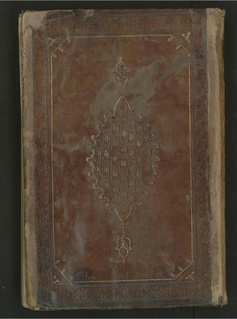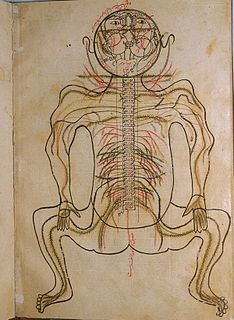
Ibn Sina, also known as Abu Ali Sina, Pour Sina, and often known in the West as Avicenna, was a Persian polymath who is regarded as one of the most significant physicians, astronomers, thinkers and writers of the Islamic Golden Age, and the father of early modern medicine. Sajjad H. Rizvi has called Avicenna "arguably the most influential philosopher of the pre-modern era". He was a Muslim Peripatetic philosopher influenced by Greek Aristotelian philosophy. Of the 450 works he is believed to have written, around 240 have survived, including 150 on philosophy and 40 on medicine.

Gorgan, formerly Esterabad , is the capital city of Golestan Province, Iran. It lies approximately 400 km (250 mi) to the north east of Tehran, some 30 km (19 mi) away from the Caspian Sea. In the 2006 census; its population was 269,226, in 73,702 families.
Abu al-Hasan Ahmad ibn Muhammad al-Tabari, born in Amol, was a 10th-century Persian physician from Tabaristan. He was the physician of Rukn al-Dawla, a Buyid ruler.
Abu Sahl 'Isa ibn Yahya al-Masihi al-Jurjani was a Persian physician, from Gorgan, east of the Caspian Sea, in Iran.
Zayn al-Din Sayyed Isma‘il ibn Husayn Gorgani, also spelled al-Jurjani, was a Persian 12th century royal Islamic physician from Gorgan, Iran. In addition to medical and pharmaceutical sciences, he was also an adept in theological, philosophic and ethical sciences. Jurjani was a pupil of Ibn Abi Sadiq and Ahmad ibn Farrokh. He arrived at the court in the Persian province of Khwarazm in the year 1110 when he was already a septuagenarian. There he became a court physician to the governor of the province, Khwarazm-Shah Qutb al-Din Muhammad I, who ruled from 1097 to 1127. It was to him that he dedicated his most comprehensive and influential work, the Persian-language compendium Zakhirah-i Khvarazm'Shahi.

Ibn Abi Sadiq al-Naishaburi, Abu al-Qasim ‘Abd al-Rahman ibn ‘Ali was an 11th-century Persian physician from Nishapur in Khorasan. He was a pupil of Avicenna. As he composed a popular commentary on the Aphorisms of Hippocrates, he was known in some circles as "the second Hippocrates". Ismail Gorgani, the author of Zakhireye Khwarazmshahi, completed his studies under his guidance.
Aḥmad ibn ‘Imād al-Dīn, Ahmad ibn Imad ad-Din was a Persian physician and alchemist. He was probably from Nishapur in the 11th century.
Shams ad-Dīn adh-Dhahabī, also known as Shams ad-Dīn Abū ʿAbdillāh Muḥammad ibn Aḥmad ibn ʿUthmān ibn Qāymāẓ ibn ʿAbdillāh at-Turkumānī al-Fāriqī ad-Dimashqī was a Syrian Turkmen Islamic historian and Hadith expert.

Manṣūr ibn Muḥammad ibn Aḥmad ibn Yūsuf Ibn Ilyās was a late 14th century and early 15th century Persian physician from Shiraz, Timurid Persia, commonly known for his publication of the colored atlas of the human body, Mansur’s Anatomy. It is important to know that al-Jurjani (1040–1136) published a book called "Zakhireye Khwarazmshahi" which Mansur could have copied the illustrations from his book.

Zakariyya' al-Qazwini, also known as Qazvini, born c. 1203 in Qazvin (Iran) and died 1283, was a Persian cosmographer and geographer of Arab ancestry.
Yuhanna ibn Bukhtishu was a 9th-century Persian or Syriac physician from Khuzestan, Persia.

In the history of medicine, "Islamic medicine" is the science of medicine developed in the Middle East, and usually written in Arabic, the lingua franca of Islamic civilization. The term "Islamic medicine" has been objected as inaccurate, since many texts originated from non-Islamic environment, such as Pre-Islamic Persia, Jews or Christian.

The practice and study of medicine in Persia has a long and prolific history. The Iranian academic centers like Gundeshapur University were a breeding ground for the union among great scientists from different civilizations. These centers successfully followed their predecessors’ theories and greatly extended their scientific research through history. Persians were the first establishers of modern hospital system.
Abū Bakr, ‘Abd al-Qāhir ibn ‘Abd ar-Raḥmān ibn Muḥammad al-Jurjānī ; surnamed "Al-Nuhwī", he was a renowned Persian grammarian of the Arabic language, literary theorist of the Muslim Shafi'i, and a follower of al-Ash'ari. He wrote several celebrated works on grammar and rhetoric, among these are Mi,ut Ạmil and Al-Jumal - introductions to Arabic syntax - and a commentary titled Al-Mughnī in three volumes.
Sa'ad al-Din Masud ibn Umar ibn Abd Allah al-Taftazani also known as Al-Taftazani and Taftazani (1322–1390) was a Muslim Persian polymath.
Ali ibn Mohammed al-Jurjani (1339–1414) was a Persian encyclopedic writer and traditionalist theologian. He was born in the village of Ṭāḡu near Astarabad in Gorgan, and became a professor in Shiraz. When this city was plundered by Timur in 1387, he moved to Samarkand, but returned to Shiraz in 1405, and remained there until his death.
Shams al-Din Muhammad b. Ahmad al-Khafri al-Kashi, known as Khafri, was an Iranian religious scholar and astronomer at the beginning of the Safavid dynasty. Before the arrival of Sheikh Baha'i in Iran, he was appointed as the major Shia jurist in the Safavid court. He was born in the city of Ḵafr, south east of Firuzābād in the region of Fārs. His exact date of birth is unknown but historical accounts estimate the date of his birth to be around the 1480s. He wrote on philosophy, religion, and astronomy, with the latter including a commentary on al-Tusi and critiques of al-Shirazi. Al-Khafri wrote works on theology and astronomy, indicating that Islamic scholars in his time and place saw no contradictions between Islam and science.
Abu Bakr Rabee Ibn Ahmad Al-Akhawyni Bokhari was a Persian physician and the author of the Hidayat al-Muta`allemin Fi al-Tibb, the oldest document in the history of Iranian Traditional Medicine (ITM). He lived during the Golden Age of Iranian-Islamic medicine and his book was used as a reference text for medical students long after his death. Al-Akhawyni Bokhari wrote about anatomy, physiology, pathology, pharmacology signs, symptoms and treatment of the disease of his time. His reputation was based on the treatment of patients with mental illnesses.
Sirāj al-Dīn Mahmūd ibn Abī Bakr Urmavī was a Persian-speaking Iranian Shafiʽi jurist, logician and philosopher from Urmia in Azerbaijan, a region in north-western Iran. He spent most of his scholarly life in Ayyubid-ruled Cairo, and from 1257 in Seljuk-ruled Konya. The Iranian diaspora he was part of, proficient in Persian and Arabic, contributed majorly to the Islamization and Persianization of Anatolia. Most of his extant works were written in Arabic but there is also one known work in Persian. He was an acquintance of Rumi.






